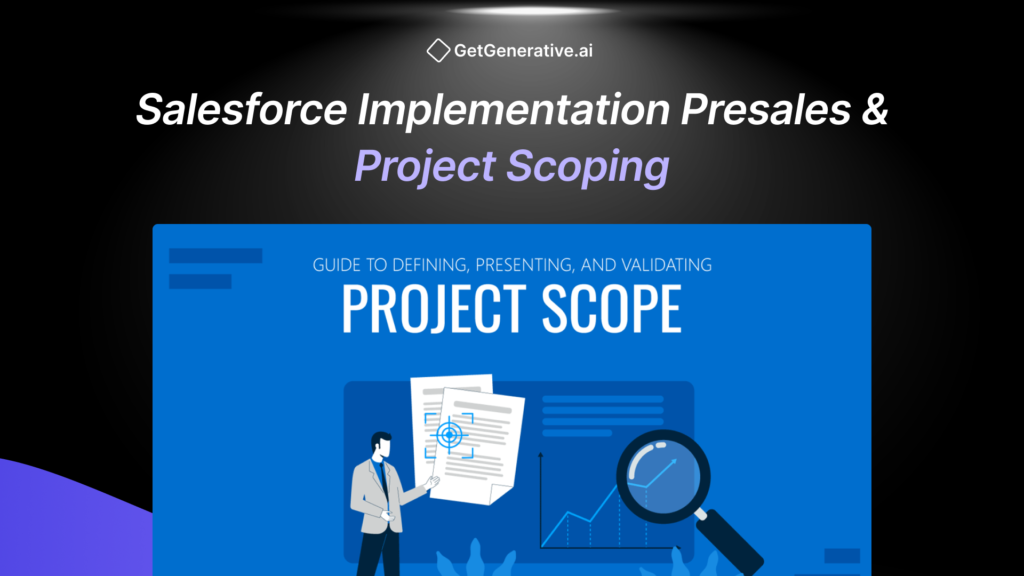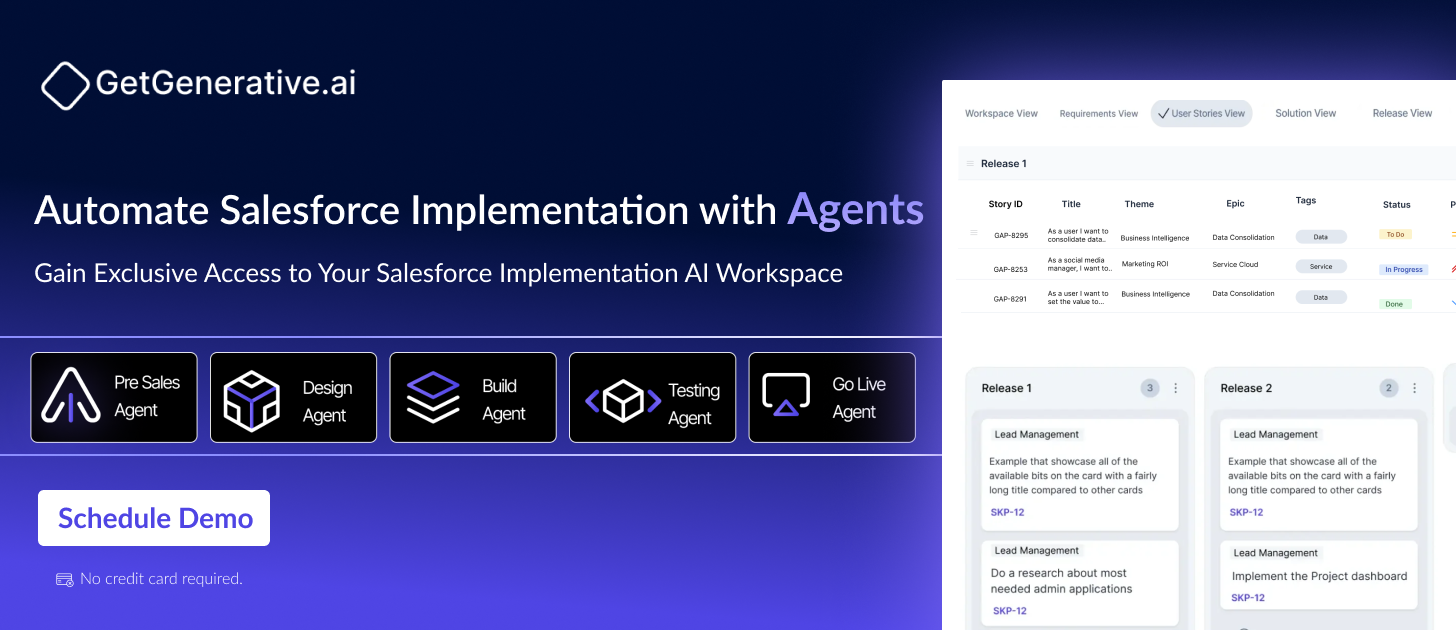Salesforce Implementation Presales & Project Scoping
Salesforce is showing no signs of slowing down — by 2025, its annual revenue is expected to hit around $38 billion. It’s a clear sign that more and more businesses are depending on Salesforce to power their operations.
Source: P&S Intelligence
But here’s the thing: the real success of a Salesforce implementation doesn’t start with the first line of code. It starts way earlier — in the presales and project scoping phase. That early groundwork sets the tone for everything that follows, helping teams align expectations, allocate the right resources, and avoid challenges down the road.
What is Salesforce Presales?
Salesforce Presales refers to all the strategic and technical conversations, evaluations, and planning that take place before a Salesforce project is officially initiated. This includes identifying business needs, defining scope, understanding budgets, and ensuring technical feasibility. It’s not just about selling — it’s about setting the stage for a successful delivery.
Why Presales is Crucial for Salesforce Projects
Skipping or rushing through the presales process can lead to missed requirements, misaligned expectations, and inflated timelines. A well-structured presales phase allows both the sales and delivery teams to work from a shared understanding of what’s being promised — and what it will take to deliver.
Think of presales like drafting a blueprint before building a house. Without it, you might end up with an impressive façade but a weak foundation. In Salesforce projects, that translates into scope creep, delayed launches, or features that don’t meet the business’s needs.
Project Scoping in the Salesforce
Project Scoping is the act of defining what the project will and won’t include. In Salesforce, this involves identifying which clouds will be used, how many users will be onboarded, what integrations will be needed, and how the platform will be customized.
Without clearly scoped requirements, it’s easy for expectations to balloon or for critical work to fall through the cracks.
Challenges of Scoping Without a Framework
Organizations that rely on spreadsheets or generic documents often struggle with consistency and clarity. Estimates may vary wildly between sales reps. Important assumptions may be left undocumented. And timelines might be overly optimistic or padded with unnecessary buffer.
Without a repeatable framework, each scoping session becomes a reinvention of the wheel. That’s not just inefficient — it’s risky. Inaccurate scoping leads to underestimation, missed deadlines, and dissatisfied clients.
Key Components of Effective Presales Scoping
So how do you create a scoping process that’s both thorough and efficient? The answer lies in combining smart tools with a structured approach. Let’s break down the essential components.
Discovery and Stakeholder Alignment
The first step in scoping is understanding the client’s world. This means conducting discovery sessions to gather business goals, current challenges, existing systems, and future vision. It’s not just about asking what features they want — it’s about understanding the “why” behind those features.
These sessions should involve both decision-makers and end-users. Sales leaders might focus on revenue goals, but service reps can shed light on operational pain points. Bringing everyone to the table early avoids costly misunderstandings down the line.
“When deploying AI, whether you focus on top-line growth or bottom-line profitability, start with the customer and work backward.”
- Rob Garf, Vice President and General Manager, Salesforce Retail
Scope Libraries and Templates
Using pre-built scope templates can accelerate the scoping process without sacrificing accuracy. A scope library includes reusable components for common project types, like Sales Cloud setup, Service Cloud customization, or CPQ configurations.
Templates not only save time — they ensure consistency across teams. Instead of writing everything from scratch, sales engineers can select pre-validated components and adjust them based on client-specific needs. This makes the process scalable and repeatable.
Accurate Timelines and Effort Estimation
One of the trickiest parts of presales is estimating how long a project will take. Timeline builders help translate scope items into realistic schedules based on historical data and project size.
Effort calculators can take estimated hours for a core role (like a developer or architect) and automatically extrapolate the required effort for related roles, ensuring that time and budget estimates are grounded in reality.
This prevents both under- and over-scoping — two of the most common pitfalls in Salesforce implementation projects.
Roles, Rates, and Resource Modeling
An accurate scope isn’t just about tasks — it’s about people. Scoping tools should allow you to assign specific roles (like Business Analyst, Technical Architect, or QA Tester) and associate them with predefined rates.
This enables the sales team to calculate labor costs early, incorporate margins, and set realistic pricing. It also helps delivery managers plan staffing in advance, reducing the risk of bottlenecks or resource shortages once the project kicks off.
Pricing and Margin Visibility
Salesforce deals can be structured as Time & Materials (T&M) or Fixed Fee. Either way, having pricing visibility during presales is key.
A built-in pricing engine allows teams to apply discounts, factor in travel expenses, and see real-time impact on profit margins. This level of transparency not only speeds up approvals but also ensures deals are aligned with company policies from the start.
Also Read – Challenges in Salesforce Presales
Asking the Right Questions During Presales
A good scoping session isn’t about running through a checklist. It’s about uncovering details that shape the entire implementation. That’s why your discovery questions need to be tailored to Salesforce-specific scenarios.
The goal here isn’t just to gather requirements — it’s to uncover unknowns, challenge assumptions, and define boundaries. Let’s break down some critical areas to explore during discovery.
Data Migration Considerations
Data migration is often more complicated than clients expect. Asking the right questions upfront helps define both effort and risk.
- What systems currently store the data that will be migrated to Salesforce?
- What’s the volume and complexity of the data?
- Are there duplicate records, dirty data, or old fields that need cleansing?
- Will legacy data need to be archived or fully imported?
These questions help determine the tooling and strategy needed — whether it’s a simple import or a multi-phase migration using middleware or custom scripts.
Integration Requirements
Salesforce doesn’t operate in a vacuum. Most businesses rely on a mix of systems — from ERPs to marketing platforms and internal databases. Understanding how these systems interact is key to getting scoping right.
- What external systems need to be integrated?
- Are the APIs available and well-documented?
- Will the integration be real-time or batch-based?
- Are there security or compliance constraints?
This area often requires input from technical SMEs, as some integrations might demand custom connectors or middleware solutions.
Also Read – What Is the Role of a Presales Manager in Salesforce?
Customization and Workflow Mapping
One of Salesforce’s biggest strengths is its ability to adapt to a business’s processes. But that also means every client wants something a little different.
- What are your core business processes?
- Are there approval workflows or automations that must be replicated?
- Will custom objects or components be needed?
- Are there compliance workflows tied to specific industries?
Capturing these details early prevents misalignment between the platform’s capabilities and the client’s expectations.
Collaborating With Subject Matter Experts (SMEs)
Salesforce projects are rarely one-size-fits-all. If the presales team doesn’t have deep expertise in a specific product area — such as Experience Cloud, CPQ, or Nonprofit Success Pack — it’s smart to bring in a subject matter expert.
SMEs don’t just answer technical questions. They help uncover complexities the client may not even realize exist. For instance, a CPQ specialist can ask targeted questions about pricing models and discounting rules that a generalist might overlook.
This collaboration improves accuracy, reduces rework, and builds credibility with the client. It also ensures that no part of the project is scoped in isolation or with incomplete context.
Create Proposal in Minutes with GetGenerativeAI
GetGenerative.AI dramatically reduces manual effort, speeds up delivery, and minimizes costly errors. Instead of spending hours on manual proposal creation, planning, development, and testing, teams can rely on intelligent agents to do the heavy lifting.
- Pre-Sales Agent creates accurate proposals with cost and resource estimates
- Design Agent auto-generates solution designs, reducing manual planning
- Build Agent automates configuration and development tasks
- Test Agent handles validation, cutting down testing time and errors
- Deploy Agent streamlines deployment with minimal manual effort
- Support Agent proactively monitors systems to prevent expensive issues
Conclusion
Salesforce implementation isn’t just about writing code or configuring workflows — it’s about solving business problems. And the first step in solving those problems is understanding them fully through a structured presales and scoping process.
By focusing on proactive discovery, leveraging reusable templates, involving SMEs, and using smart tools like Estimator, organizations can dramatically improve their win rates and project outcomes.
Presales isn’t a checkbox. It’s your foundation. Do it well, Use AI to make it easier, faster, and more successful.




